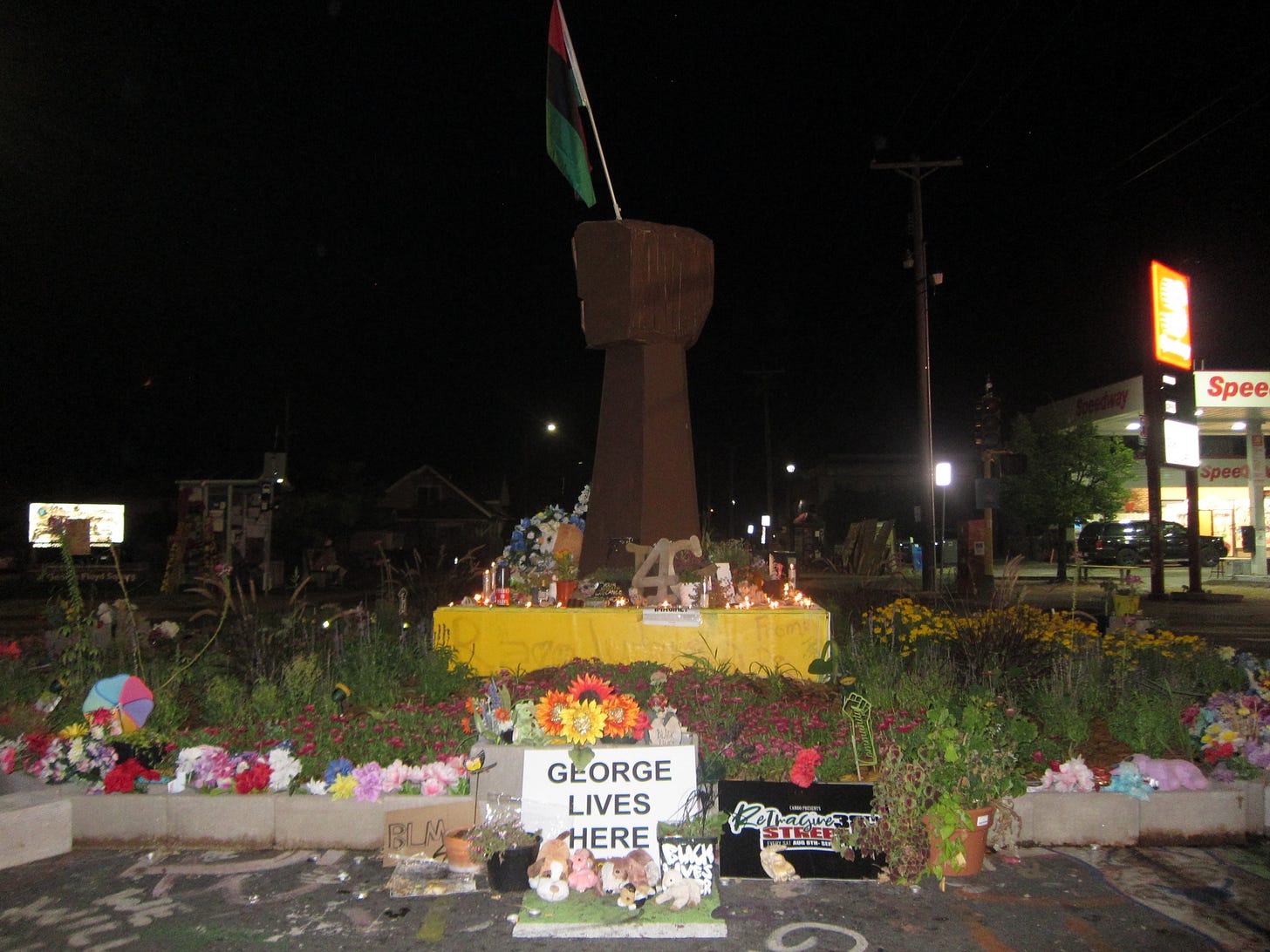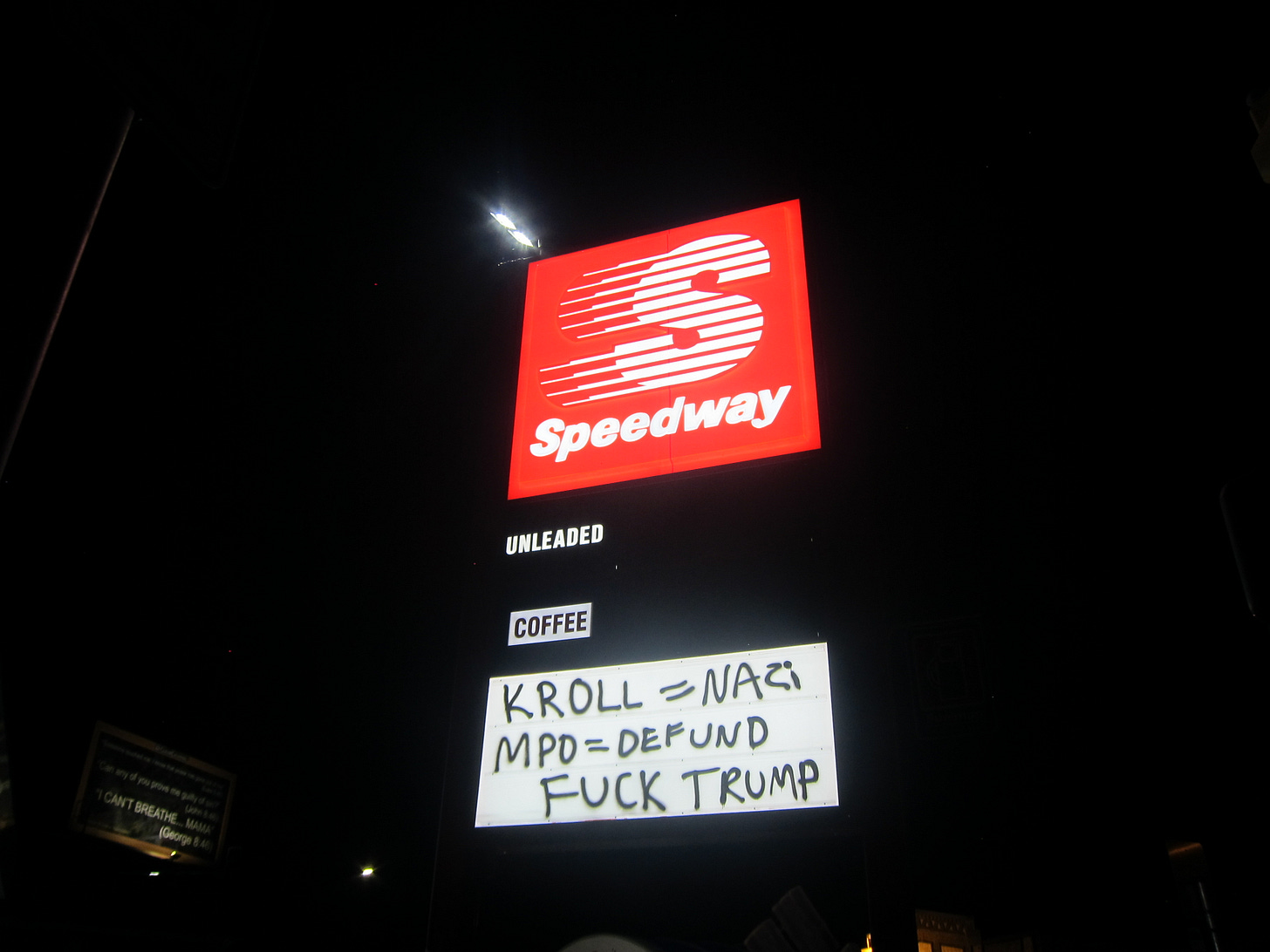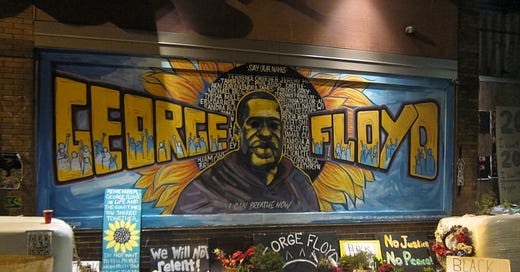GEORGE FLOYD MURAL'S DESECRATION WAS MORE THAN A DRUNK AND DERANGED ACT
Radical aesthetics establish the sovereignty of occupied spaces—and protestors are still reeling from the fall-out

The vandalized George Floyd mural (All photos by moi unless otherwise noted)
It’s been one week since the authorities said they’d start taking down the barricades of George Floyd Square, but the cops still haven’t breached the borders. Somewhere behind closed doors, the omnipotent hand of the state is surely maneuvering to dismantle this free state—which has been occupying the four blocks surrounding the street where Floyd was murdered for 92 days (and counting) since his death in late May. Every passing day now feels like a countdown. But the monolithic signs listing the protestors’ demands remain erect at the entryways, greeting sweaty tourists who make pilgrimages from all over the world to gawk at ground zero of the revolution.


The barricades at George Floyd Square
One week is a lifetime when nothing is promised, and everything can flip on a dime. Unpredictable crises erupt at any moment in autonomous zones, puncturing the stillness of this infernal summer heat. Last Tuesday, a 26-year-old white man named Daniel Michaelson slunk into George Floyd Square and spray-painted a giant portrait of Floyd near the sidewalk where he was murdered. This was hardly the first time Black Lives Matter artwork has been vandalized; murals in Florida, New York, California, Ohio, Illinois, Texas and more have all been defaced in recent months. (Just a few days ago, a woman dressed as a blood-soaked Statue of Liberty poured paint on the BLM mural in front of Trump Tower for the third time.)

A portrait of Floyd in the middle of New York’s autonomous zone
The art of autonomous zones holds a particular purpose. Political murals (and graffiti!) serve to define and delineate the parameters of these occupied territories—which exist only in their ability to hold space—thereby transforming everyday streets into political sanctums with their own visual and linguistic codes. To put it simply: the radical aesthetics of autonomous zones are foundational to their identities, distinguishing these spaces from the status quo.
At the CHOP in Seattle, artists painted all over the plywood barricades that defended the occupied territory. In New York’s Abolition Park, a painting of Floyd was staked in the center of the autonomous zone like a conquering flag. In Philadelphia, humanizing portraits of the encampment’s houseless residents decorated signboards around the perimeter. George Floyd Square’s murals are particularly poignant because this site is also one of mourning, loss, and death—thus, desecrating his portrait feels like spitting on a grave. But vandalizing art in autonomous zones is graver than acts of flagrant disrespect—it is an affront to the autonomous zone’s right to exist, on par with the removal of its barricades.

A Black Power fist in the center of George Floyd Square

A billboard above George Floyd Square
On Sunday evening, a circle of mostly women with a light sprinkling of men at the abandoned gas station in the middle of the autonomous zone for a nightly community meeting. They took seats on a few shabby couches and benches parked between graffiti-covered gas pumps, cracking cans of Mountain Dew. Marcia Howard, a leader and mother hen of the zone, stepped into the ring. Marcia is a high school English teacher and ex-marine, and she spoke with the easy authority of someone used to commanding fickle attention spans.

Protestors attending the nightly social-distanced meeting
“There are four rules in George Floyd Square,” Marcia yelled. “Number one! Assume everyone has COVID—back up, mask up.”
“Number two! Assume everybody in this square is armed, act accordingly.”
“Number three! Assume everything you do or say is being recorded.” Marcia glanced up to the gas station’s ceiling, where she knew a police camera was monitoring everything.
“Number four: do not assume that everybody has your liberation in mind. There are ops everywhere.” She thumped her chest, where a body camera was strapped in with a harness.
“If you say something, you better mean it, and say it with—thump—your whole—thump—chest.”

The abandoned gas station sign
Marcia sat back down and began to recount what happened on the night of the vandalism—disputing the vandal’s claim to the media that he was black-out drunk and has no memory of what happened. According to Marcia, “Defacing Daniel” was recorded on a surveillance camera bringing flowers to the mural around 10pm. “This was premeditated—homeboy laid flowers down like he was a mourner and was acting all shifty-eyed,” Marcia said. “Sure enough, he took the spray can out and did what he did, then he ran like his ass was [Black Olympic athlete] Carl Lewis.”



Protestors pursued and caught up to him a few blocks away, where they snapped a picture of him for identification. “He smiled for the picture, he was so proud,” noted Marcia. “And he was chased by a recovering alcoholic and captured by a Muslim—neither smelled alcohol on him.” When one pursuant asked Defacing Daniel why he ran, he replied, “I thought you were going to rob me,” Marcia added, exclaiming with disgust, “Racist!”
“Someone should have beat him up,” cried one protestor.
“That’s not what we do,” chided Marcia. “Because we believe in people over property.” Instead of calling police, the protestors held their own process of community restorative justice, choosing to have a conversation with Daniel instead of acting like a lynch mob, Marcia noted. After interrogating him about his motives, they asked if he wanted to step foot into the zone again. He said no—so they let him go.
“I suspect he was on drugs, not drunk,” posited a white woman. “Just the weirdness of his behavior…”
Marcia shook her head. “You don’t have to ascribe pathology to white supremacy.”
“Also—‘I was drunk’ is like the ‘I was kidding’ of excuses in the fascist handbook!” exclaimed another protestor.
Mmmm, the crowd murmured in agreement to a chorus of finger snaps.
If you maybe want to help me buy Marcia a nice dinner one night (!)—and think this immersive journalism project is worth supporting—please consider subscribing to a paid tier. Rave New World is an independent newsletter entirely fueled by readers’ paid subscriptions.

An abandoned bus station in the square
Defacing Daniel was a medical student at the University of Minnesota, and following his vile act, his community has sought its own form of accountability, with thousands of people signing a petition to strip him of his white coat. “We have been witness to a spectrum of racist actions and beliefs of our fellow classmates, faculty, and administration towards students and patients of color,” University of Minnesota Medical School students wrote in a separate community letter. It went on the list examples of systemic racism and white supremacy in medicine—from experimental surgeries on Black female slaves, to false beliefs about biological differences still held by medical students today.

A clothes line running across the autonomous zone dangles free masks
“It’s interesting that one of their own doing something so egregious got [these students] to self-interrogate what it means to be a white person in medicine, and hold their school accountable,” noted Marcia. But the protestors agreed on one point: the outrage generated from this incident should be directed towards their larger goals, which include securing a $400,000 investment from the city to fund a youth jobs programs for the surrounding neighborhood. “People were really irate online—let’s use that power for good,” said Marcia. “It shouldn’t be about taking away his white coat, it should be about getting the city to fulfill our demands.”
She took a deep breath.
“I need this revolution to not be fucked up by fuck shit.”

After the meeting, Marcia took a seat next to the medical tent and beckoned me over, Googling my name to make sure I wasn’t a narc. Then, she started reminiscing about her life in the old world, before the pandemic flipped everything on its head. Scrolling through old photos on her phone, she showed me pictures of herself in prim schoolteacher dresses and the desert confections she used to bake—all saturated in bright and rosy colors, as if she were living life through an Instagram filter. “I was trying to do my Martha Stewart shit,” she said with a sad smile. It all felt so distant.
“I was radicalized when I saw federal troops coming past my students’ houses,” Marcia continued, telling me that she immediately took a leave of absence once she witnessed those nightmarish scenes. “I needed to be completely present—this is my life now,” she said. “My full-time job is being Black.” Marcia’s house is close enough to the autonomous zone where she can see it through her kitchen window, and she has only left eight times in the last 92 days. “I went outside to eat eggs the other day, and I felt so naked,” she laughed.
Still, she couldn’t take her eyes off the old photos on her phone as she hunched over the screen—as if she could be sucked back into an alternate reality where she was a schoolteacher glowing with happiness rather than the mother hen of an anarchic autonomous zone, marching around in a bulletproof vest, spending all her time shuttling between the Mayor’s office and diffusing conflicts between insurgents, alt-right attackers, and protestors.

A protestor named Vinee performs the nightly ritual of lighting candles next to the names of those slain by police
Suddenly, someone grabbed Marcia from behind. “Black-and-white spotted at the barricade,” they said, and she shot up from her chair like a bolt, disappearing into the night. (It turned out to be a false alarm: the cops had been called for a dispute outside the autonomous zone.)
It was already midnight, so I cut back to Floyd’s mural to take a closer look at the damage before heading out. It had quite literally been defaced—his face was smeared with black paint, two eyes blackened into iris-less circles as if they had been gauged out. The effect was chilling and dehumanizing—his gaze looked haunted and demonic. A strange rustling sound surrounded the memorial, and I couldn’t shake the feeling like eyes were watching me from afar. (Maybe I was just paranoid about the police security cameras.) Either way, I was spooked, so I hopped on my bike and peddled swiftly back home. The moon was a spooky sliver of foggy yellow and the warm night air was eerily still, like the calm before a storm. I went to bed with my phone volume turned up, waiting for the emergency Signal that the end has come.


